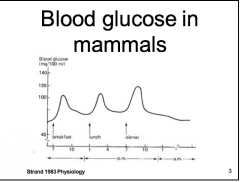![]()
![]()
![]()
Use LEFT and RIGHT arrow keys to navigate between flashcards;
Use UP and DOWN arrow keys to flip the card;
H to show hint;
A reads text to speech;
11 Cards in this Set
- Front
- Back
|
What's the "milieu interieur"? |
The "internal environment." The temperature in the environment is one thing, but body temperature of an organism could be completely different (or the exact same.) |
|
|
What does the typical day in the life of a mammal look for glucose levels? |

|
|
|
Conformity vs. Regulation? |
Most animals will do a bit of both. Conformity costs virtually no energy, but you need to rely on the environment and hope it's going to give you what you want. Regulation is awesome because you control your own body regardless of what the environment says, but regulation costs a lot more energy. |
|
|
Define the "Zone of Intolerance" |
The Zone of Intolerance refers to the idea that regulation has a limit. You can regulate your body, but at a certain point, you'll find that if the environment differs too heavily, you won't be able to maintain regulation. |
|
|
Homeostasis |
The coordinated physiological processes which maintain most of the constant states in the organism. In plain english: The way that an organism's physiology works under ideal circumstances. "Relatively stable internal environment (milieu intérieur)" |
|
|
What are the three steps in homeostasis? Think of the emperor penguin. |
Sensor compares the value given to the "set point" (optimal) Tells effectors, which then change the value. Then the variable remains controlled. This is called a negative feedback loop because essentially the end result stops the sensor from sensing a value other than the set point. |
|
|
Positive feedback? |
When the control system actually reinforces the deviation from a controlled set point. (So when your body says, yeah, keep changing, even though it's going towards something that isn't your typical set point. |
|
|
Define scaling |
The study of how specific properties (structural, mechanical, physiological) will scale with size. |
|
|
Isometric scaling |
DIRECT proportionality. 1 to 1 slope. Y = aX |
|
|
Allometric scaling |
When the scaling happens against size. It isn't linear because as length increases the size increases 8 fold. |
|
|
Per mass of organism, and elephants heart takes up more or less than that of a human? |
Just about the same. Hearts scale isometrically. |

